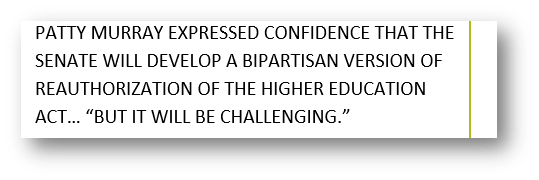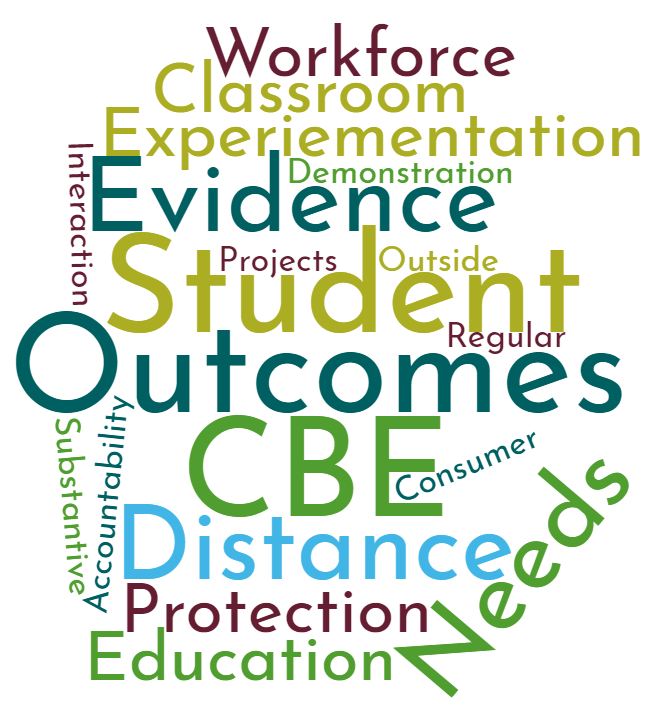The Senate is moving ahead with deliberations on its version of a bill to reauthorize the Higher Education Act (HEA). Yesterday morning, the Health, Education, Labor, and Pensions Committee held a hearing focusing on “access and innovation.” Much was said about such issues as competency-based education, distance education, accountability, supporting students outside the classroom, and consumer protection. We thought you would enjoy some background on the testimony provided and the main themes we were hearing.
Opening Remarks Signal a Bipartisan Effort
To begin with, the Senate will tend toward more bipartisan solutions than the House. Its version of reauthorization (the PROSPER Act) was completely a Republican product. While the Senate Committee leaders from both parties have their own points-of-view, there is a greater sense of cooperation than we see most anywhere else in the Capitol these days.
Senator Alexander (TN), Chair, HELP Committee
The Senator has been both a university president and the Secretary of Education, so he has an uncommon knowledge of higher education issues among our Congressional members. The bottom line for him is: “How can we get the Federal Government out of the way so that we can meet our students’ needs?”
Senator Patty Murray (WA), Ranking Minority Member, HELP Committee
The Senator is very concerned about expanding opportunities for low-income, minority, homeless, working adult, and other populations not well served by higher education. While she is interested in access, that is not sufficient. She seeks to help students navigate program choices, graduate on-time, and have credentials that improve their careers and the community, at large.
Accountability was a key issue. Developing appropriate “guard-rails” to protect students was a phrase she introduced and was echoed throughout the hearing. She felt online and competency-based education should be part of the conversation, but that students in these programs often are not given the help they need to succeed. “We cannot be allured by innovation for innovation’s sake and hurt students in the process. We must have evidence,” was another point she made that reappeared in different forms throughout the hearing.
“We cannot be allured by innovation for innovation’s sake and hurt students in the process. We must have evidence,” was another point she made that reappeared in different forms throughout the hearing.
She said that she is confident that they can find a bipartisan solution, but that it will be challenging. After Sen. Murray completed her remarks, Sen. Alexander observed: “I can tell from each of our opening statements that we are listening to each other. And that’s a good sign.”
Witnesses Provided Examples of Successful Innovations
The HEA hearing had five witnesses from a variety of institutions and organizations. Each of them provided testimony regarding their institution or specialties, and the Senators asked follow-up questions. The questions and the direction of the discussion revolved around the topics that the witnesses presented.
Dr. Joe May, Chancellor, Dallas County Community College District, spoke about career and technical education through certificates and associate degrees (and recommended that these be Pell eligible). He also championed more transparency of job acquisition information. He described Dallas County Promise, a partnership between school districts, institutions, and the local community to increase college completion through dual credit courses, saying dual enrollment decreases access barriers and reduces time to degree completion. He discussed the limitations of federal reporting structures, specifying that we should allow institutions to track all enrolled students, regardless of categorization. He recommended allowing DACA recipients to be eligible for Pell. Dr. May advised that the EQUIP program (a Department of Education Experimental Sites Initiative) allows for institutional partnerships with non-institutional education providers. Under this program, Dallas County Community College District partners with non-institutional provider StraighterLine and CHEA for quality assurance.
Ms. Donna Linderman, University Dean for Student Success Initiatives for the City University of New York (CUNY), testified about CUNY’s Accelerated Study in Associate Program (ASAP). The program aims to graduate 50% of their students within three years. When started, the graduation rate was 13% (or 24% for students with no remedial needs). Since its founding in 2007, ASAP has served 33,800 students and has a 53% three-year graduation rate (compared to 25% for other programs). ASAP helps students with financial and needs “outside the classroom,” such as tuition waivers, textbook assistance, transportation. There also is great emphasis on student support, such as personalized advising, tutoring, career development. ASAP is being replicated in New York and other states. She recommended support for community colleges to adopt evidence-based models to improve graduation rates through wholistic programs like ASAP.
Dr. Barbara Brittingham, President, Commission on Institutions of Higher Education, New England Association of School and Colleges, addressed four issues.
- Key elements to distance education quality (institutional capacity; institutional control over academics, admission and support services; faculty and professional development; and monitoring student progression).
- Quality CBE programs: students should be required to reach a “competency” level. Competencies need to be equivalent to credit-hour systems (in case of transfer to another institution).
- “Disaggregated” faculty role: some institutions employ multiple individuals to fulfill the roles previously accomplished by one faculty member. We must ensure expertise of individuals hired in these roles.
- Experiments for accreditors: HEA should provide options for accreditors to experiment with assuring educational quality. Some examples include differentiated accreditation or accreditation of systems (instead of institutions).
Dr. Deborah Bushway, Consultant, Competency-Based Education Network, and Provost at Northwestern Health Sciences University, discussed the potential of CBE to increase post-secondary educational opportunities. Dr. Bushway stressed that more work is needed to standardize the definition of CBE across post-secondary education, recommended that Congress define CBE within the HEA andalso authorize a CBE demonstration project to pilot changes before attempting to deploy the innovations more broadly.
Mike Larsson, President of Match Beyond, co-founded his nonprofit (which is partnered with Southern New Hampshire University) to help students from low-income families earn college degrees. Their program acts like a “personal trainer” for students, providing enrollment coaching, academic coaching, support services such as free lunches, parking vouchers, free childcare, and career coaching. 72% of their enrolled students are on track to complete or have already finished their associate degrees.
Key Themes
Accountability, Evidence, and Outcomes
The need to change accountability measures (whether within institutions, for accreditation, or for federal aid purposes) was a strong theme. Terms such as evidence-based, research-based, rigorous evaluation, progression, graduation rates, employment outcomes, and community gains from academic programs were raised repeatedly. While these calls were pointed at gaining a better understanding about which innovations deserve continued investments, Larsson opined: “outcome data should not be just for innovation.”
The federal ban against a unit record system to help with such analyses was mentioned a few times in the hearing and was noted by several on the Twitter feed. Sen. Elizabeth Warren (MA) noted the bipartisan College Transparency Act, which proposes to lift that ban so that better student information could be provided.
Bushway made a great point in observing that it will take time to develop effective outcomes measures, but a more robust set of demonstration projects could progress these innovations in the meantime. Brittingham also said that the credit hour is currently our only currency and that it is time to explore alternative measures of proficiency. Again, this will take time.
Student Needs Outside the Classroom
Several Senators and visiting witnesses discussed the importance of supporting student needs outside of the classroom. Institutions are trying to focus on helping students with their urgent needs, so the students can focus on being successful in the classroom. This wholistic student support approach is, as Ms. Linderman said, a “critical piece of the student success puzzle.” CUNY’s ASAP program and Larsson’s Match Beyond programs have both studied the typical barriers to student completion and provide answers to these barriers. These solutions include offering grants to cover gaps in financial aid, helping with transportation or parking costs, offering child care, providing free lunches, and providing personalized coaching for academic and career needs.
Demonstration Projects
We have reported in the past about the Experimental Sites Initiatives (such as EQUIP) that the U.S. Department of Education initiated in the past. These programs allow institutions to forego some federal financial aid regulations to implement an innovation. New America released a report earlier this week criticizing the lack of evidence generated by these Initiatives in the past. The report made recommendations on how to conduct true experiments. The expansion and improvement of demonstration projects to assess the efficacy of innovations was suggested several times.
Distance Education is Still Suspect
Sen. Murray cited the dismal research record of distance education in serving minority, low income, and other undeserved students. Sen. Elizabeth Warren’s (MA) remarks were all about making sure students are well-informed about their options and that they have safeguards protecting them against unscrupulous providers. Again, the tone was that innovations are suspect…and may always be so. One of the panel witnesses thought that the “regular and substantive interaction” requirements should remain for distance education but be removed for CBE.
Sen. Johnny Isakson (GA) noted how he and Sen. Mike Enzi (WY) were on a committee a few decades ago to review “web-based education.” At that time, a 50% rule was created so that less than 50% of all instruction could be at a distance for an institution to be eligible for aid. He noted that we need to update our thinking. He noted that the Army has most of its students learning via distance education and that its time to get our arms around how to define it.
In any case, we still have work to do on the story of the efficacy of distance education.
Consumer Protection
From what is written above, you probably gathered that there was great emphasis in finding the proper “guard-rails” that allow innovation, protect students, and assure that federal aid funds are spent wisely. Given the history in which a select few have used correspondence and distance education in ways that have harmed students, the Senators are wise to help protect future students. Meanwhile, several Senators are interested in removing cumbersome regulations actually inhibit student progress. It will be an interesting balancing act.
Workforce Needs
Innovative ways to meet workforce needs were often cited, which is not surprising given this Administration. Allowing Pell grants to be used for short term certifications with value in the workplace was often suggested. Additional flexibility in aid for adults who often need to return to education in short spurts throughout their lives was suggested.
Competency-Based Education and “Regular and Substantive Interaction”
There was much support for the concept of CBE. The Senators (mostly) seemed to appreciate the flexibility for students and the attention to quality exhibited in CBE programs. Sen. Orrin Hatch (UT), whose state is home to Western Governors University, was very focused on supporting CBE. Many Senators seemed to support writing a new CBE definition, and for creating demonstration programs to further develop it.
On “regular and substantive interaction,” Brittingham noted that when that definition was created in 1992, a faculty person performed all the roles of course development, instruction, assessment, and advising. Now, institutions (such as WGU) have disaggregated those roles. She said it is time to modernize interaction to keep pace with changes in faculty practices.
As noted above, it was suggested that “regular and substantive interaction” be removed from CBE but be retained for distance education. We hope that we can push forward regulatory reforms for all innovations and not pit them against each other as some are inclined to do.
In Conclusion and Next Steps…
We need to continue to observe what is happening and be active participants in the process. The Committee asked for definitions of “competency-based education,” “distance education,” and “correspondence education.” Shall we do so? Sen. Alexander invited such input.
There was discussion about an issue that we have been struggling with since the House’s PROSPER Act was released. In that bill, they replaced “distance education” with “competency-based education” in the definitions and in the accreditation oversight section. Since regulation always lags innovation, it is time for us to think bigger. Let’s create “guard-rails” that can be applied to any innovation. The one sure fact that we can’t escape: innovations that we cannot even imagine are on their way. Let’s create regulations that can work for any innovation, so we don’t have to worry about the problem of trying to define “distance education” and “competency-based education” after decades of experience with these modalities. We will think more about this and may make some suggestions in future posts.
Meanwhile, what do you think. What “guard-rails” are needed? What regulations are needed? What changes to regulations are needed? What changes to the financial aid program are needed?
-Russ and Lindsey

Russell Poulin
Director, Policy & Analysis
WCET – WICHE Cooperative for Educational Technologies
rpoulin@wiche.edu @russpoulin

Lindsey Downs
Manager, Communication
WCET – WICHE Cooperative for Educational Technologies
ldowns@wiche.edu @lindsey0427

 “We cannot be allured by innovation for innovation’s sake and hurt students in the process. We must have evidence,” was another point she made that reappeared in different forms throughout the hearing.
“We cannot be allured by innovation for innovation’s sake and hurt students in the process. We must have evidence,” was another point she made that reappeared in different forms throughout the hearing.




4 replies on “Senate Weighs Innovation and Access Options in Reauthorizing Higher Ed Act”
I also greatly appreciated Dr. Brittingham’s testimony that included her 5 questions that could get to the quality question about programs.
1) Is course content based on appropriate expertise?
2) Is the course design appropriate to the learning goals, student body, and the modality of instruction?
3) Are assessments reliable and valid?
4) Do students get the appropriate help when they need it?
5) Programs are coherent and periodically reviewed.
First, thank you so much for keeping on top of all of this and for devoting a good deal of time to RSI and how it plays out with CBE and DE. It is important for us to have a clear picture of what is going on as the government grapples with innovation. It would seem that good guidelines and regulations for demonstration programs should be created!
Regarding RSI, there is a difference in how it plays out in CBE and I think there should be a different standard. However, definitions of just about everything are so out-dated! As you have noted in recent blog posts with Van Davis, times have changed radically and the way we offer courses has evolved with the rapidly improving technical capabilities, but we are dealing with old definitions and retrofitted reporting requirements. Cleaning the discrepancy between what was happening ten years ago, is critically important.
I am dismayed when conversations like the ones needed for the reauthorization, take us backward down the road of the efficacy of online learning. We are showing great gains in educating in the online environment. It can be for everyone who wants or needs to be accessing education online, if we resource properly. How do we keep the old-time skepticism out of the discussion and tge need for resourcing in?
I’d like to se discussions focusing on increased resource provisioning for all students.
Pat James
Project Consultant
California Community Colleges Online Education Initiative.
[…] Representatives has weighed in with its PROSPER Act, which was a purely one-party production. The Senate has been holding hearings and may soon deliver its own, more bipartisan, version in the coming […]
[…] conversations in Senate Health, Education, Labor, and Pensions Committee meeting on the reauthorization of the Higher Ed Act focused on dual or concurrent enrollment. Concurrent […]